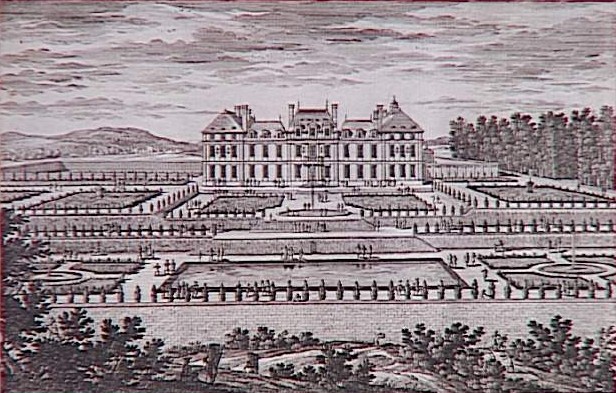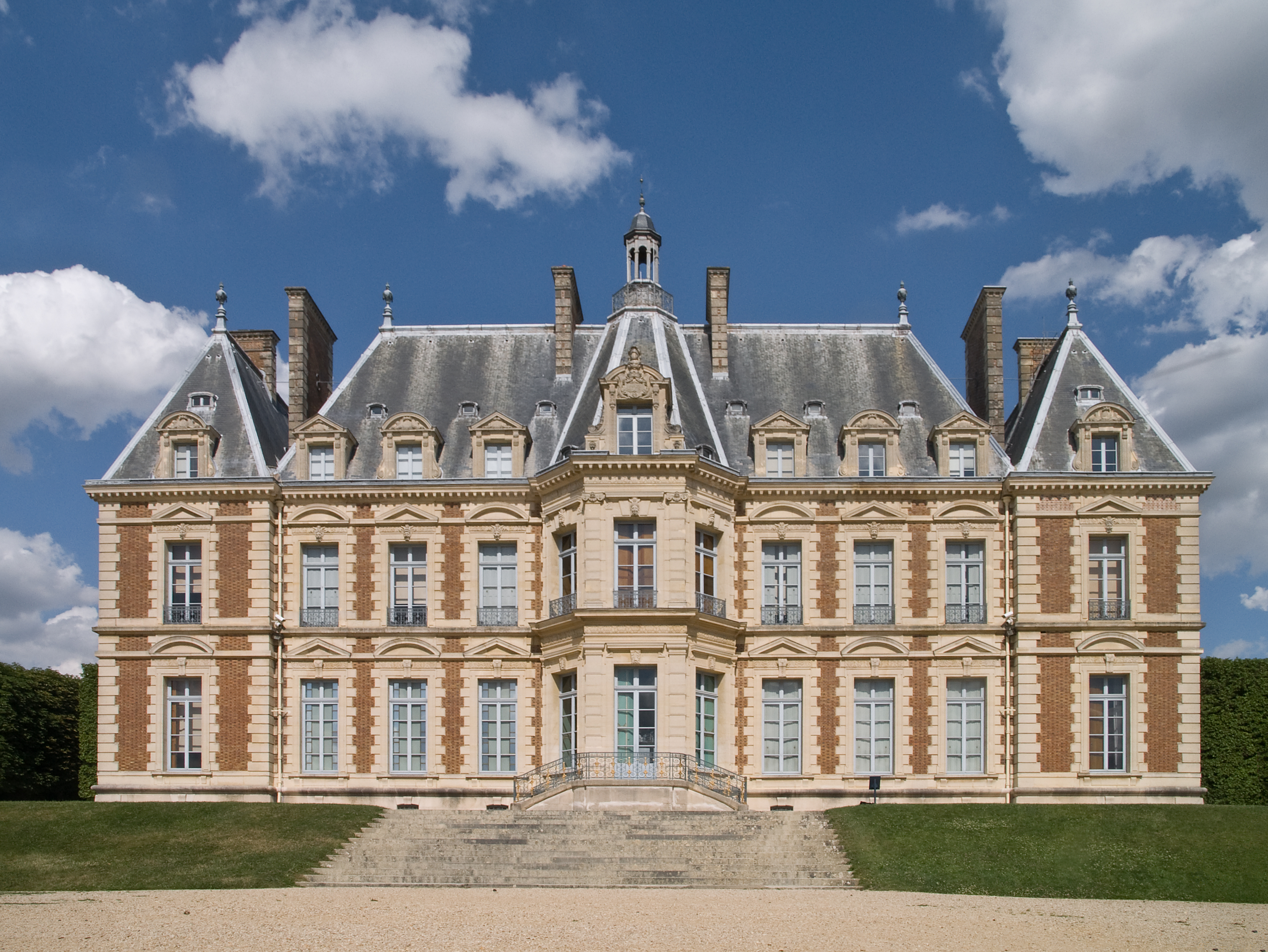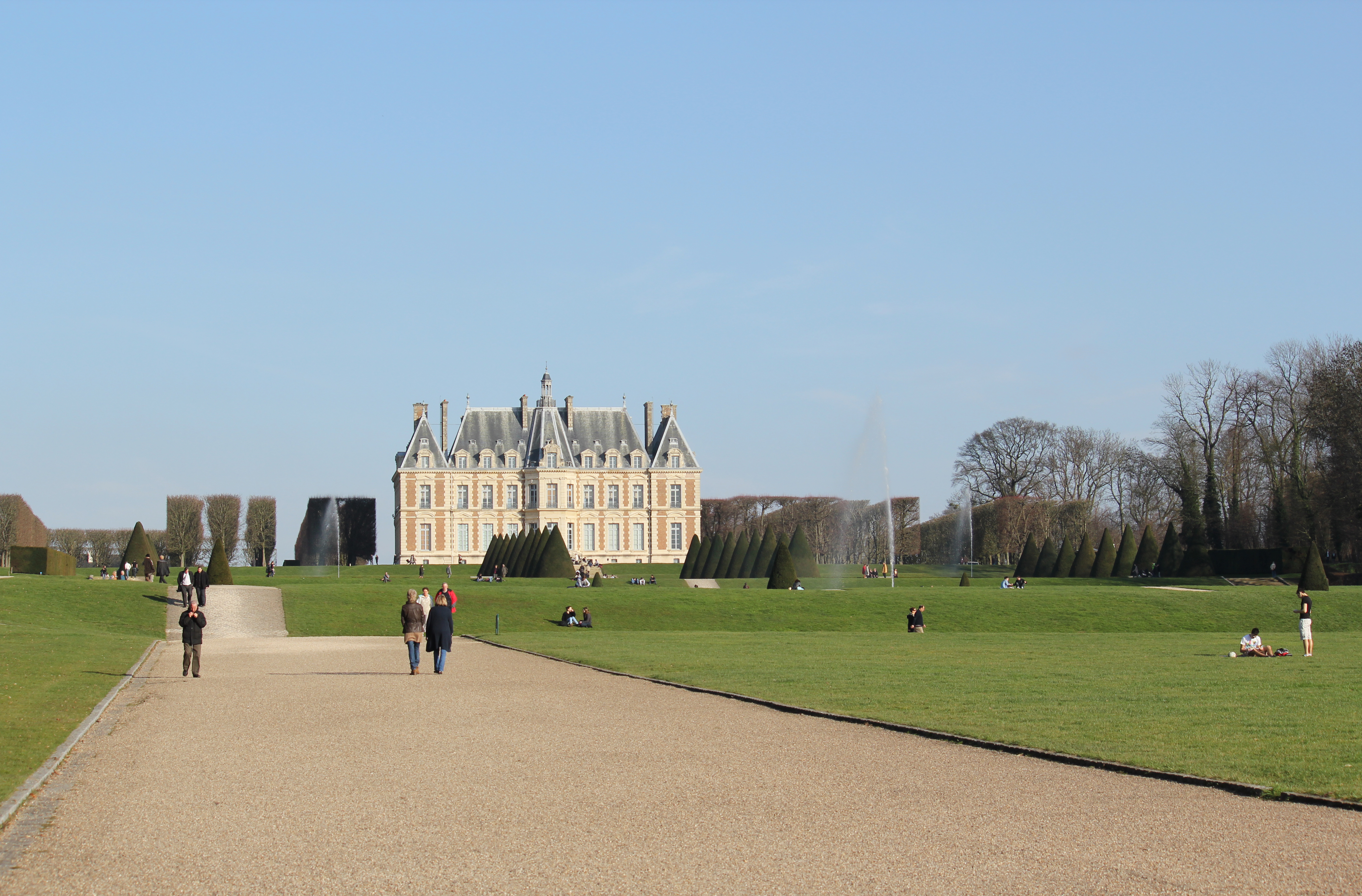Château de Sceaux on:
[Wikipedia]
[Google]
[Amazon]
The Château de Sceaux is a grand


 The duc de Trévise, son of Napoleon's Maréchal Mortier, who had married the daughter of M. Lecomte, inherited the ''domaine'' and set to restoring the park and the pavilion and Orangerie. The gardens were restored, with parterres and gravel largely replaced by clipped lawns. In 1856-62 he erected the present smaller château in brick with stone quoins, designed to evoke the style of Louis XIII, designed by the architect Augustin Théophile Quantinet and built by Joseph-Michel Le Soufaché.
In 1922, the heiress of Trévise, princesse de Faucigny-Cystra, planned to give up Sceaux to real estate developers; through the efforts of the mayor Jean-Baptiste Bergeret de Frouville it was preserved and opened to the public of the town that had grown up around the park.
The duc de Trévise, son of Napoleon's Maréchal Mortier, who had married the daughter of M. Lecomte, inherited the ''domaine'' and set to restoring the park and the pavilion and Orangerie. The gardens were restored, with parterres and gravel largely replaced by clipped lawns. In 1856-62 he erected the present smaller château in brick with stone quoins, designed to evoke the style of Louis XIII, designed by the architect Augustin Théophile Quantinet and built by Joseph-Michel Le Soufaché.
In 1922, the heiress of Trévise, princesse de Faucigny-Cystra, planned to give up Sceaux to real estate developers; through the efforts of the mayor Jean-Baptiste Bergeret de Frouville it was preserved and opened to the public of the town that had grown up around the park.
Musée du Domaine départemental de Sceaux
{{DEFAULTSORT:Château de Sceaux Sceaux Sceaux Châteaux with formal gardens in France Museums in Hauts-de-Seine Art museums and galleries in Île-de-France Decorative arts museums in France Historic house museums in Île-de-France
country house
An English country house is a large house or mansion in the English countryside. Such houses were often owned by individuals who also owned a town house. This allowed them to spend time in the country and in the city—hence, for these peop ...
in Sceaux, Hauts-de-Seine
Sceaux () is a commune in the Hauts-de-Seine department in the southern suburbs of Paris, France. It is located from the centre of Paris. In 2019, Sceaux had a population of 20,004.
A wealthy city
Sceaux is famous for the Château de Sceaux, ...
, approximately from the centre of Paris
Paris () is the capital and most populous city of France, with an estimated population of 2,165,423 residents in 2019 in an area of more than 105 km² (41 sq mi), making it the 30th most densely populated city in the world in 2020. Si ...
, France. Located in a park laid out by André Le Nôtre
André Le Nôtre (; 12 March 1613 – 15 September 1700), originally rendered as André Le Nostre, was a French landscape architect and the principal gardener of King Louis XIV of France. He was the landscape architect who designed the gard ...
, visitors can tour the house, outbuildings and gardens.
The Petit Château operates as the Musée de l'Île-de-France, a museum of local history. The commune operates the site as Musée du Domaine départemental de Sceaux.
The former château was built for Jean-Baptiste Colbert
Jean-Baptiste Colbert (; 29 August 1619 – 6 September 1683) was a French statesman who served as First Minister of State from 1661 until his death in 1683 under the rule of King Louis XIV. His lasting impact on the organization of the country ...
, Louis XIV
Louis XIV (Louis Dieudonné; 5 September 16381 September 1715), also known as Louis the Great () or the Sun King (), was List of French monarchs, King of France from 14 May 1643 until his death in 1715. His reign of 72 years and 110 days is the Li ...
's minister of finance, who purchased the ''domaine'' in 1670. The present château, designed to evoke the style of Louis XIII
Louis XIII (; sometimes called the Just; 27 September 1601 – 14 May 1643) was King of France from 1610 until his death in 1643 and King of Navarre (as Louis II) from 1610 to 1620, when the crown of Navarre was merged with the French crow ...
, dates from the Second Empire. Some of Colbert's outbuildings remain, as well as the bones of the garden layout.
History
The seigneurie of Sceaux appears in 15th century documents, but little remains above ground of the château built for the family Potier de Gesvres in 1597. Colbert turned to some of the premier royal architects and craftsmen to design a seat worthy of his station, the architect brothers Claude andCharles Perrault
Charles Perrault ( , also , ; 12 January 1628 – 16 May 1703) was an iconic French author and member of the Académie Française. He laid the foundations for a new literary genre, the fairy tale, with his works derived from earlier folk tale ...
and Antoine Lepautre, and the ''premier peintre du roi'' Charles Le Brun.

Jean-Baptiste Colbert, Marquis de Seignelay
Jean-Baptiste Antoine Colbert, Marquis de Seignelay (1 November 1651 – 3 November 1690) was a French politician. He was the eldest son of Jean-Baptiste Colbert, nephew of Charles Colbert de Croissy and cousin of Jean-Baptiste Colbert de Torc ...
, son of Colbert and minister of the Navy, inherited Sceaux in 1683. He added sculpture by François Girardon and Antoine Coysevox
Charles Antoine Coysevox ( or ; 29 September 164010 October 1720), was a French sculptor in the Baroque and Louis XIV style, best known for his sculpture decorating the gardens and Palace of Versailles and his portrait busts.
Biography
Coysevo ...
. His embellishments to the grounds extended the formal terraced layout, the bones of which remain, and excavated the Grand Canal, a kilometre in length, along the valley bottom. Le Nôtre laid out a main axis centered on the château and descending in a series of terraces to the valley bottom, then rising on the far side. The main axis is crossed by two grand secondary axes at right angles, one delineated by the '' allée de la Duchesse'' and the formal stone Cascade that flows down to fill an octagonal basin, the other the Grand Canal.
Jules Hardouin-Mansart
Jules Hardouin-Mansart (; 16 April 1646 – 11 May 1708) was a French Baroque architect and builder whose major work included the Place des Victoires (1684–1690); Place Vendôme (1690); the domed chapel of Les Invalides (1690), and the Gran ...
built the Orangerie
An orangery or orangerie was a room or a dedicated building on the grounds of fashionable residences of Northern Europe from the 17th to the 19th centuries where orange and other fruit trees were protected during the winter, as a very lar ...
, which was inaugurated by the King at a fête in 1685. Sceaux was sold in 1699 to Louis' illegitimate son, the duc du Maine, whose wife, Anne, duchesse du Maine made it the setting for her glittering salon
Salon may refer to:
Common meanings
* Beauty salon, a venue for cosmetic treatments
* French term for a drawing room, an architectural space in a home
* Salon (gathering), a meeting for learning or enjoyment
Arts and entertainment
* Salon ( ...
in the first decades of the eighteenth century, which reached its apogee in the ''Grandes Nuits'' of 1714–15, sixteen fêtes of music and opera-ballets that unfolded every two weeks and drew the best musicians of France, under the direction of Jean-Joseph Mouret. The salon at Sceaux attracted the young Voltaire
François-Marie Arouet (; 21 November 169430 May 1778) was a French Enlightenment writer, historian, and philosopher. Known by his '' nom de plume'' M. de Voltaire (; also ; ), he was famous for his wit, and his criticism of Christianity—e ...
. The duchesse du Maine had the pavilion
In architecture, ''pavilion'' has several meanings:
* It may be a subsidiary building that is either positioned separately or as an attachment to a main building. Often it is associated with pleasure. In palaces and traditional mansions of Asia ...
of the Ménagerie built, to designs by Jacques de La Guépière, and gave it a garden setting, to the north of the château; only its foundations remain.
Demolition
During theFrench Revolution
The French Revolution ( ) was a period of radical political and societal change in France that began with the Estates General of 1789 and ended with the formation of the French Consulate in November 1799. Many of its ideas are conside ...
the property was confiscated as a ''bien national'', its contents sold for the benefit of the nation, and the building bought by M. Lecomte, a merchant of Saint-Malo
Saint-Malo (, , ; Gallo: ; ) is a historic French port in Ille-et-Vilaine, Brittany, on the English Channel coast.
The walled city had a long history of piracy, earning much wealth from local extortion and overseas adventures. In 1944, the All ...
. Under the Consulat, the original château was demolished, but the pavilion of Aurore, the Orangerie, the stables, and outbuildings were preserved. Crops were grown on Le Nôtre's terraces.
The restored castle

 The duc de Trévise, son of Napoleon's Maréchal Mortier, who had married the daughter of M. Lecomte, inherited the ''domaine'' and set to restoring the park and the pavilion and Orangerie. The gardens were restored, with parterres and gravel largely replaced by clipped lawns. In 1856-62 he erected the present smaller château in brick with stone quoins, designed to evoke the style of Louis XIII, designed by the architect Augustin Théophile Quantinet and built by Joseph-Michel Le Soufaché.
In 1922, the heiress of Trévise, princesse de Faucigny-Cystra, planned to give up Sceaux to real estate developers; through the efforts of the mayor Jean-Baptiste Bergeret de Frouville it was preserved and opened to the public of the town that had grown up around the park.
The duc de Trévise, son of Napoleon's Maréchal Mortier, who had married the daughter of M. Lecomte, inherited the ''domaine'' and set to restoring the park and the pavilion and Orangerie. The gardens were restored, with parterres and gravel largely replaced by clipped lawns. In 1856-62 he erected the present smaller château in brick with stone quoins, designed to evoke the style of Louis XIII, designed by the architect Augustin Théophile Quantinet and built by Joseph-Michel Le Soufaché.
In 1922, the heiress of Trévise, princesse de Faucigny-Cystra, planned to give up Sceaux to real estate developers; through the efforts of the mayor Jean-Baptiste Bergeret de Frouville it was preserved and opened to the public of the town that had grown up around the park.
Museum of Île de France
Since 2010, the Petit Château contains the Musée de l'Île-de-France. This museum contains one of the largest collections of works by painters of theSchool of Paris
The School of Paris (french: École de Paris) refers to the French and émigré artists who worked in Paris in the first half of the 20th century.
The School of Paris was not a single art movement or institution, but refers to the importan ...
.
References
Musée du Domaine départemental de Sceaux
{{DEFAULTSORT:Château de Sceaux Sceaux Sceaux Châteaux with formal gardens in France Museums in Hauts-de-Seine Art museums and galleries in Île-de-France Decorative arts museums in France Historic house museums in Île-de-France